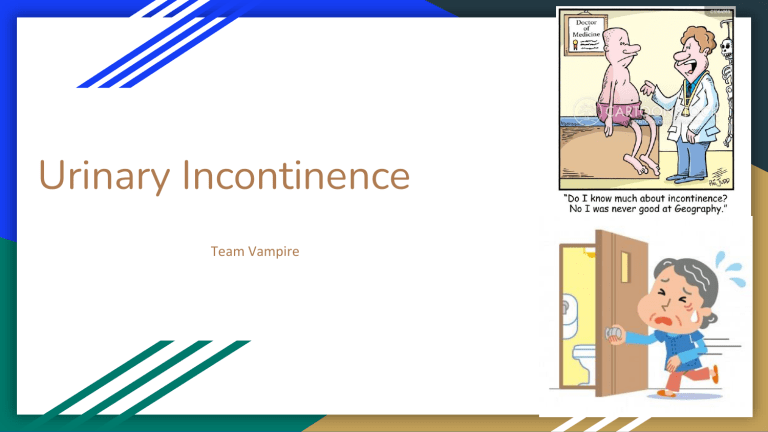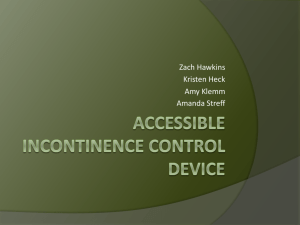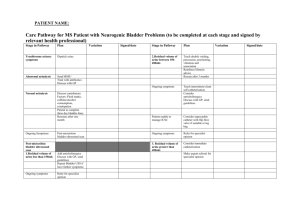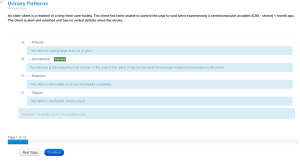
Urinary Incontinence Team Vampire Stress Incontinence Clinical Manifestations: ❖ Urine leaks when exerting pressure on the bladder by coughing, sneezing, laughing, exercising, or lifting something heavy. ➢ Can be observed in pregnancy, being overweight, and prostate cancer ❖ Women are more likely to experience stress incontinence Pharmacological Therapies: ❖ There have not yet been any medications approved specifically for stress incontinence! However… ❖ Anticholinergics can calm an overactive bladder (Ditropan XL, Detrol, Enablex, Toviaz, Vesicare, Myrbetriq) Non-Pharmacological Therapies: ❖ Pelvic Floor Exercises aka Kegel Exercises ➢ Can be used in conjunction with biofeedback and vaginal weights ❖ ❖ ❖ ❖ Managing how much and when you drink fluids Lifestyle changes including less or cessation of smoking and weight loss Bladder training is also useful if experiencing mixed incontinence More invasive therapies include: ➢ Insertion of a vaginal pessary which is a ring with two bumps that sit on either side of the urethra ■ Helps support the base of the bladder ➢ Urethral inserts ■ Similar to tampons, and thus can only be used during specific activities, and can only be worn up to 8 hours a day ➢ Surgeries including sling procedure, injectable bulking agents, retropubic colposuspension, and inflatable artificial sphincter Urge Incontinence Clinical Manifestations: Sudden, intense urge to urinate followed by an involuntary loss of urine Observed in BPH – Urge incontinence is a significant problem for men suffering from BPH and its related complications. Since prostatic enlargement reduces the amount of urine that can flow freely from the bladder, the bladder muscle tends to malfunction. Other causes of urge incontinence include: Cancer of the bladder Pharmacological Therapies: ❖ ❖ Conservative therapies (e.g., behavioral therapy and lifestyle modification) should be the first-line treatment for stress and urge urinary incontinence. Pharmacologic interventions (e.g., anticholinergics) should be used as an adjunct to behavioral therapies for refractory urge incontinence Anticholinergics. These medications can calm an overactive bladder and may be helpful for urge incontinence. Examples include oxybutynin (Ditropan XL), tolterodine (Detrol), darifenacin (Enablex), fesoterodine (Toviaz), solifenacin (Vesicare) Non Pharmacological: ❖ Nonsurgical, nonpharmacological UI treatments for women include: ❖ pelvic floor muscle training (PFMT, to strengthen the pelvic musculature) ❖ behavioral training (e.g., bladder training, to teach one to gradually hold urine for longer periods) ❖ vaginal cones (to strengthen the pelvic floor) Reflux Incontinence Reflux incontinence is defined as when the bladder muscles involuntarily contract without warning causing urine leakage Clinical Manifestations: the signs and symptoms are urinary incontinence , bedwetting , urinary retention , and bowel problems such as constipation another symptoms is a strong persistent urge to urinate , burning sensation while urinating , fever , cloudy urine Pharmacological Therapies: ❖ ❖ ❖ ❖ Anticholinergics and antimuscarinics can relax the muscles of the bladder and reduce bladder spasms (Oxytrol, Detrol, Enablex, Sanctura, Vesicare) Beta-3 agonists such as Myrbetriq can suppress involuntary bladder contractions Tricyclic antidepressants have also been found effective in relaxing the bladder muscles Topical estrogen in women can increase tone of the urethral muscle and enhance the pelvic floor muscles Non-Pharmacological Therapies: ❖ ❖ Medical inserts including urethral inserts, pessary, slings, and and artificial sphincter can also be applied to aid in the control of reflux incontinence. Those experiencing reflux incontinence can also pursue bladder training, scheduled bathroom breaks, pelvic muscle exercises, and double voiding. Overflow incontinence Overflow incontinence is defined as frequent or constant dribbling of urine due to a bladder that doesn't empty out completely this can be caused by a weak bladder muscle or a blockage caused by bladder outlet obstruction or urethra which is the tube that carries urine out of the body Can also be caused by increase in urine volume due to diabetes Clinical Manifestations: signs and symptoms * constant dribbling * leaking urine *always urinating but only a small amount comes out * feeling like you never empty your bladder Pharmacological Therapies: Medicine that can be taken for overflow incontinence are alpha blockers which relaxes the muscles throughout the body specifically the bladder neck and urethra which would cause increase of urine flow , medicine that can be taken are described as alpha blocker drugs including cardura, ,hytrin , flomax, rapaflo etc . Non-Pharmacological Therapies: Bladder training , behavioral treatments , pelvic floor exercises , the avoidance of caffeine , the use of pads , and in some cases surgery




